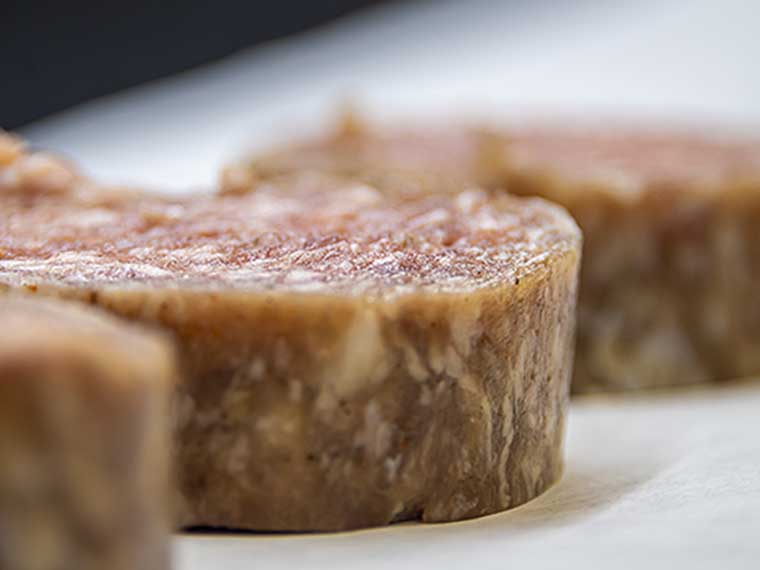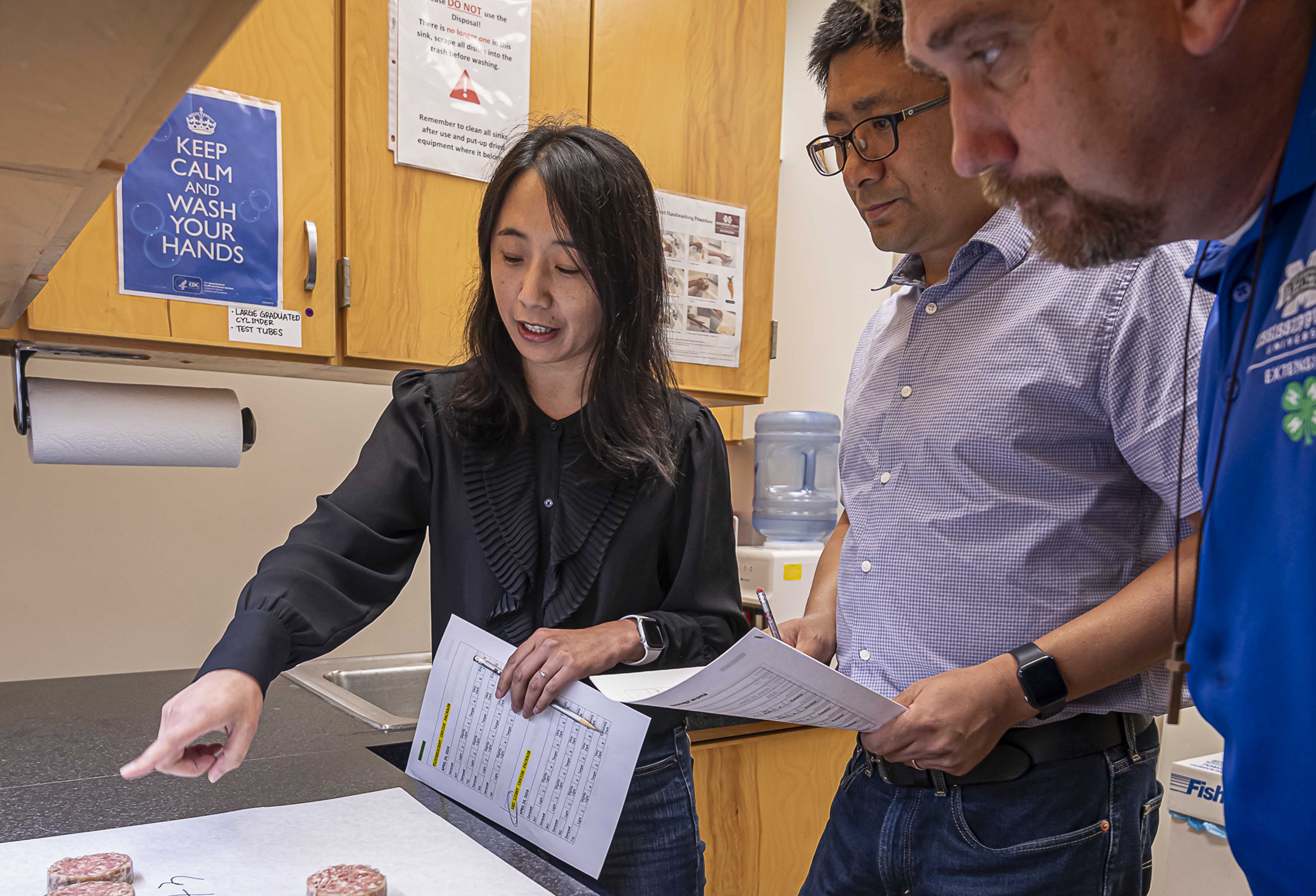The information presented on this page may be dated. It may refer to situations which have changed or people who are no longer affiliated with the university. It is archived as part of Mississippi State University's history.
In the United States, 30 to 40 percent of our food supply is wasted. Much of this waste is caused by bacterial contamination during processing and packaging of food products before it even reaches the supermarket. Mississippi Agricultural and Forestry Experiment Station (MAFES) scientists are taking a closer look at the bacteria that spoil our food to help extend shelf life and reduce waste.
Determining the identity of the spoilage-causing bacteria in food is a first step in combating the issue. History shows us high cost and technical limitations have delayed the development of effective ways to identify and quantify the culprit. This poses a food safety threat as the microorganisms present in meat products not only affect shelf life but can harm humans.
Dr. Xue Zhang, an assistant research professor in the Department of Food Science, Nutrition and Health Promotion and principal investigator of the study, is researching how to extend shelf life of fresh meat products, specifically pork sausage. The current shelf life of fresh pork sausage is about one to two days in the refrigerator after the "sell-by" date.
"Our goal is to extend the shelf life of fresh pork sausage by at least two to three days. To reach our goal we must go back to the beginning and control the bacteria in the raw material, which is what we are focusing on," Xue Zhang said.
The team seeks to develop a disinfection process to decrease bacterial contamination in pork processing plants and apply strategies to prevent or control the growth of specific spoilage-causing bacteria. They also hope to use the data found to leverage a NIFA grant application, focusing on novel foods and innovative manufacturing technologies.
The molecular method used to identify the bacteria is Oxford Nanopore Technology (ONT), which can be used to identify the bacteria found in meat products. This technology has been used in research to detect harmful pathogens that make people sick but has not previously been used to evaluate spoilage bacteria in food. Through this method the team can identify and quantify spoilage-causing bacteria in pork sausage.
"In sausage, you may find 1,000 different forms of bacteria. Some bacteria are good, and some are bad. With the molecular techniques we have been using we can identify the type and relative abundance of bacteria found in the product. From there, we can identify which bacteria spoil the meat. Once we properly identify the bacteria that cause spoilage, we can inhibit or slow down their growth, possibly extending the shelf life of the pork," Xue Zhang said.
They also aim to discover how antimicrobials affect spoilage-causing bacteria in refrigerated sausages.
"The most prominent spoilage causing bacteria found was Brochothrix thermosphacta. After evaluating the bacteria's profile, we discovered that adding buffered dry vinegar in sausage inhibits bacterial growth. We were able to extend the meat's shelf life by one to two days. Now we know that this antimicrobial works because it can slow down the growth of the prominent spoilage-causing bacteria. Our research became hypothesis driven after figuring that out because now we want to know if there are any other antimicrobials that can better control these bacteria," Xue Zhang said.
Currently, fresh pork sausage treated with microbials will last around seven to ten days in the refrigerator, but the type of antimicrobials and the packaging used also play a role.
The team is also exploring how the quantity of spoilage-causing bacteria impacts the rate of meat spoilage.
"While one type of bacteria may need a million cells to spoil your meat, another kind may only need 1,000 cells. By identifying that difference, we can better determine which bacteria are the biggest threats," Xue Zhang said.
Dr. Li Zhang, a poultry science assistant professor and MAFES scientist, is the co-principal investigator of the research.
"The project's potential to significantly reduce food waste through innovative source-tracking methods is what drew me in," Li Zhang said.
He discussed the project's challenges and how they hope to overcome them.
"Some shortcomings identified through the DNA sequencing methods being used is that you can identify the bacteria, but you can't see if it is alive or dead. This happens because when you check the DNA, you kill the bacteria, which can cause ineffective results. Also, these techniques cause you to amplify the bacteria and form numerous copies of it, but these copies only show the relative quantity of the bacteria present. To get the best results we must be able to see the absolute quantity of the bacteria, which is something we are still working toward."
Li Zhang said it can also be difficult to identify the sources of contamination in the production of fresh pork sausages.
"This is due to the multifaceted nature of the sausage production processes; each step presents potential entry points for microbial contamination. These stages include grinding, mixing, stuffing, and packaging. To address this challenge, enhancing regular monitoring throughout the production chain is critical," Li Zhang said. "However, we are actively working on strategies to address these challenges."
The team hopes to continue incorporating novel ways of decreasing food waste and expand their research to other proteins, including fish and chicken.
"Interdisciplinary collaboration is crucial to mitigate the risk of microbial contamination in pork sausage production. Our research will not only benefit the meat industry by extending shelf life but also reduce the number of bacteria on meat that can be harmful to humans. Together, we can reduce food waste and improve health benefits for the consumer," Li Zhang said.
This research is funded by the Mississippi Agricultural and Forestry Experiment Station (MAFES) Special Research Initiative.
In sausage, you may find 1,000 different forms of bacteria. Some bacteria are good, and some are bad ... Once we properly identify the bacteria that cause spoilage, we can inhibit or slow down their growth, possibly extending the shelf life of the pork.
Dr. Xue Zhang
Behind the Science

Li Zhang
Assistant Professor
Education: B.S., M.S., Food Science, Northeast Agricultural University, China; Ph.D., Nutrition, Mississippi State University
Years At MSU: The cycle of teaching, learning, and innovating is what drives me every day.
Focus: Agricultural microbiomes, animal health, and food safety
Passion At Work: The cycle of teaching, learning, and innovating is what drives me every day.

Xue Zhang
Assistant Professor
Education: B.S., M.S., Food Science, Northeast Agricultural University, China; Ph.D., Food Science and Technology, Mississippi State University
Years At MSU: 11
Focus: Meat quality, microbiome, and sensory analysis
Passion At Work: My research improves meat quality and safety by studying the relationship between meat, microbial communities, sensory traits, and production methods, ensuring sustainable, and nutritious meat for consumers.


